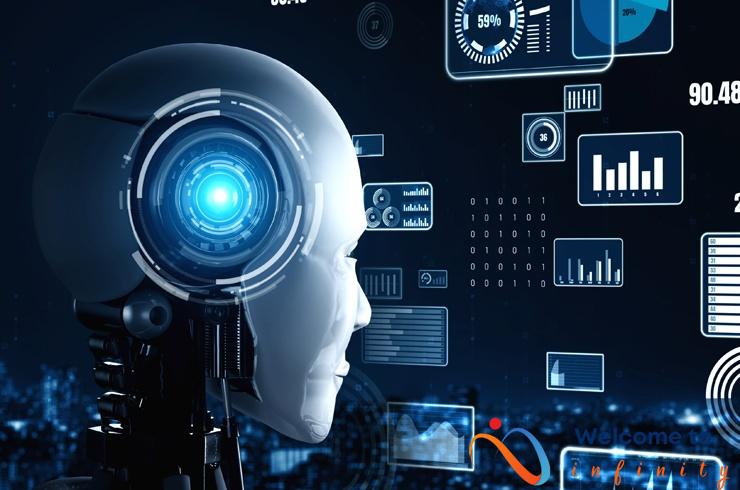Artificial Intelligence has taken the retail industry by storm, providing a more personalized and seamless shopping experience for customers. AI-powered systems are capable of analyzing huge amounts of data, including previous purchase history, behavior patterns, and preferences to deliver personalized shopping options and recommendations for each customer.
In addition, AI has also improved customer service through the use of chatbots and virtual assistants that are available 24/7. These assistants can engage with customers in real-time, provide product recommendations, and answer questions. This level of personalized support enhances the overall shopping experience, boosting customer satisfaction rates.
One of the significant benefits of AI in retail is that it allows for dynamic pricing and product bundling. Dynamic pricing algorithms adjust the pricing of products based on competition, demand, and other factors, optimizing revenue while driving sales. Moreover, AI helps retailers identify the most appropriate products to bundle with the best price, which can increase sales and customer satisfaction.
Additionally, AI algorithms are also used to manage inventory levels, reducing waste, and lost sales from product shortages and overstocking. Furthermore, augmented reality technology has allowed customers to visualize products in real-time, providing them with a unique and immersive shopping experience while reducing the likelihood of returns. Finally, AI-powered payment systems that use facial recognition and biometrics have improved the checkout speed and security, making for a hassle-free, secure, and seamless shopping experience.
Chatbots and Virtual Assistants
Chatbots and virtual assistants are a game-changer in the retail industry. These AI-powered tools are not only providing 24/7 support to customers but are also personalizing their shopping experience by offering tailored recommendations. Chatbots are available on websites, apps, and social media platforms, making it easier for customers to get support and information on products wherever they are.
One of the greatest advantages of chatbots and virtual assistants is their ability to learn from customers' interactions and provide increasingly accurate recommendations over time. They can track things like purchase history, browsing behavior, and click-through rates, and use that information to offer personalized product suggestions to the customer in real-time.
- Chatbots can also assist customers in finding the right product, making the purchase, and tracking their order status, all in one place.
- Virtual assistants, such as Amazon's Alexa and Google Assistant, can assist customers with making a shopping list, finding the nearest store, and placing orders with voice commands.
- Chatbots and virtual assistants can also provide instant and helpful responses to frequently asked questions, reducing the workload of customer service representatives and allowing them to focus on more complex issues.
With chatbots and virtual assistants in place, retailers can offer round-the-clock support while keeping their operational costs lower than traditional customer service methods. Chatbots can handle multiple customer conversations simultaneously, providing quick and efficient support to customers, and saving time and resources for retailers. As customers continue to expect personalized interactions with retailers, chatbots and virtual assistants represent an exciting and effective solution for providing an outstanding customer experience.
Personalized Recommendations
With the help of AI, retailers can now analyze customer data to provide personalized product recommendations. By understanding the customer's behavior, purchase history, and preferences, AI algorithms create tailored recommendations that match the customer's taste. This enhances the overall shopping experience, as customers feel that their needs are being met. Personalized recommendations also increase sales by introducing shoppers to products that they might not have found on their own, leading to a higher number of purchases.
One way retailers are using personalized recommendations is by showing products related to the ones the customer is currently browsing. For instance, if a customer is looking at shirts, retailers can use AI to suggest matching pants or accessories. Another technique that AI is using to enhance the recommendation system is by creating customer-specific shopping carts with a list of recommended products. This not only makes purchasing easier but also increases the chances of customers completing the transaction.
In addition to increasing sales, personalized recommendations also improve customer satisfaction. With AI's help, customers can save time and find the products they love faster, creating a sense of loyalty. Retargeting and personalized email marketing are other ways retailers can use AI to provide tailored recommendations and engage customers further.
AI's ability to provide personalized recommendations is changing the way retailers approach marketing and sales. With it, retailers can target the most relevant customers, providing customized product recommendations and increasing sales while improving customer satisfaction.
Dynamic Pricing
Dynamic pricing algorithms are revolutionizing the retail industry by adjusting prices in real-time based on various factors, such as demand, competition, and inventory levels. By constantly monitoring and analyzing these factors, retailers can optimize revenue and drive sales without sacrificing profit margins.
This AI-powered pricing strategy also allows retailers to offer personalized discounts and promotions to individual customers, further enhancing the shopping experience. With dynamic pricing, retailers can efficiently respond to changes in market conditions and offer competitive prices, gaining a competitive edge over their rivals.
One of the most significant benefits of dynamic pricing is its ability to increase revenue and profits even during times of low demand. This pricing strategy encourages impulse buys by offering discounts on products that are often overlooked, ultimately increasing sales and customer satisfaction.
Moreover, dynamic pricing algorithms allow retailers to identify which products are selling well and bundle them up to offer at discounted prices. This not only increases sales but also enables retailers to clear out stock and make room for new products.
Overall, dynamic pricing algorithms are a game-changer for the retail industry. They allow retailers to be more agile and responsive to market conditions, optimize revenue, and offer a personalized shopping experience to their customers. As the technology advances, we can expect to see even more sophisticated and effective pricing strategies that will redefine the retail landscape.
Product Bundling
In the retail industry, bundling refers to the practice of offering multiple products for sale as a package deal. With AI-powered algorithms, retailers can identify the best products to bundle together based on customer data and purchase history.
Through personalized recommendations, the AI system can offer bundle deals that make sense for the customer, increasing the likelihood of a sale. For example, if a customer has recently purchased a laptop, the AI system can suggest bundling it with a set of speakers or a laptop bag at a discounted price.
This not only boosts sales but also increases customer satisfaction, as customers feel they are getting more value for their money. Additionally, with AI's ability to analyze purchasing patterns and trends, retailers can adjust their bundling strategy in real-time for optimal results.
Overall, with the help of AI, retailers can create personalized bundle deals that benefit both the customer and the business, ultimately increasing sales and customer loyalty.
Inventory Management
Inventory management is a critical aspect of retail, as it directly impacts sales and profitability. Inefficiencies in inventory management can lead to waste, stockouts, overstocking, and lost sales. AI algorithms can optimize inventory levels by analyzing data such as sales history, product demand, seasonality, and trends. This data can be used to forecast demand and adjust inventory levels accordingly, reducing the risk of stockouts and overstocking.
AI-powered inventory management systems can also recommend reorder points and safety stock levels, ensuring that products are always available to customers. By minimizing stockouts and overstocking, retailers can increase sales and reduce waste. A well-managed inventory can increase efficiency, reduce costs, and improve the bottom line.
AI algorithms can also help retailers manage their inventory in real-time, providing accurate visibility into stock levels and shipment status. By tracking inventory levels and sales, retailers can respond quickly to changing demand and make informed decisions on pricing and promotions. This helps retailers stay competitive and meet customer expectations.
Additionally, AI-powered inventory management systems can help retailers reduce waste and minimize the environmental impact of their operations. By optimizing inventory levels and reducing waste, retailers can decrease their carbon footprint, lower costs, and enhance their brand image.
In conclusion, AI-powered inventory management systems can transform the retail industry by increasing efficiency, reducing waste, and improving customer satisfaction. By leveraging AI algorithms, retailers can optimize inventory levels, reduce costs, and enhance their competitiveness while creating a seamless and personalized shopping experience for their customers.
Augmented Reality
Augmented Reality (AR) technology is another AI-powered tool being used in the retail industry to enhance the customer experience. By using AR, customers can see products in real-time and visualize how they would look in their homes or on their bodies, improving engagement and reducing the likelihood of returns. AR can also provide customers with more product information, creating a more informative and interactive shopping experience.
One example of AR in retail is with furniture companies. Customers can use their smartphones to see how a piece of furniture would fit in their homes before making a purchase. By seeing how the product would look in their space, customers are more likely to make a purchase and less likely to return the item.
- AR can also be used in fashion to allow customers to see how clothing would look on them before making a purchase.
- AR technology is also useful for providing customers with additional information about a product, such as ingredients for cosmetic products or nutritional information for food items.
- Another way AR is being used in retail is through interactive displays. Customers can use their smartphones to unlock AR experiences, adding an extra layer of engagement to their shopping experience.
In conclusion, AR technology is revolutionizing the retail industry by providing customers with a more engaging and informative shopping experience. By allowing customers to visualize products in real-time, AR increases the likelihood of sales and reduces the likelihood of returns, providing a win-win situation for both the retailer and the customer.
Facial Recognition and Payment Systems
AI-powered payment systems using facial recognition and biometrics are revolutionizing the checkout process in retail stores. These systems enable customers to complete their purchases quickly, reducing wait times and saving them valuable time.
Facial recognition technology allows the system to identify customers quickly and securely, reducing the need for traditional methods such as entering a PIN or signature. This not only speeds up the transaction process but also enhances security by ensuring that only authorized individuals are completing the payment.
Additionally, biometric authentication such as fingerprint scanning can be used to provide an additional level of security to the payment process. This ensures that only the owner of the account can access and complete the transaction, reducing the risk of fraud.
Facial recognition and payment systems are also incredibly convenient for customers, allowing for a seamless and contactless shopping experience. This is becoming increasingly important in today's world, where hygiene and social distancing are critical.
Overall, AI-powered payment systems using facial recognition and biometrics offer a secure, efficient, and convenient checkout process for customers. As this technology continues to evolve, we can expect to see even more innovative solutions that will transform the shopping experience for customers.












